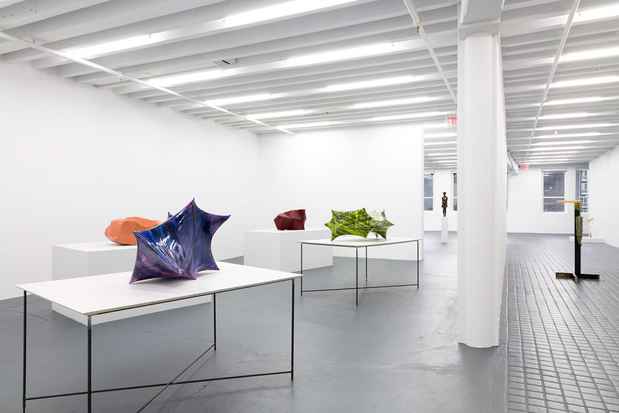Jean-Luc Moulène “Hole, Bubble, Bump”
Miguel Abreu Gallery (88 Eldridge St.)

This event has ended.
“This exhibition finds its coherence in the making or fabrication of each object,” says Jean-Luc Moulène, “in the sense that each object is responsible for manifesting a specific thinking, if you will. I deemed it a good idea to bet on the coherence of the making of each work over a period of time to produce a coherent exhibition – true or false, I don’t know. I preferred making that bet over a language bet that would come to federate the works at hand. In other words, there is no external ‘word’ pointing the objects toward some shared goal. Only retroactively, after making the works, did I realize that most of the objects had holes, bubbles, or bumps! And perhaps all three have a metaphoric dimension. ‘Bubble’ simply put relates to the question of illusion. ‘Hole’ has as much to do with the question of passage, as it engages the issue of a lack, or something missing.” The holes in the bronze sculptures Josephine, for instance, and Masque (Marc Gilbert) correspond to missing information in the 3D scans. They are the result of the incapacity of the software to interpolate and intersect images. In more general terms, the scan transforms things from an image space into a volume space. It’s like a reversal of Alberti. Finally, a ‘bump’ is typically the outcome and outgrowth of a shock.
The show is organized chronologically and unfolds like a ritual. At the entrance of the exhibition, Moulène placed the tutelary figure, L’Ange du Buisson. “There is an announcement effect as soon as you enter the show, if you will, something which offers the elements of a sacrament…” This bronze talismanic figure of a bird comes from found flint and limestone pieces, which include the impression of a sea urchin at the center. The viewer accumulates information, as he or she encounters the works in a sequence, a progression that function like a knot. Moulène inquires whether a simple and repeated interrogation of materials can constitute a kind of coherence? Rituality, for its part, proposes a logic of a different order. If both hypotheses – that of coherence of production and that of rituality – coincide, we have truth.
The objects guiding the viewer through the show offer an idea of the body as composition, a body that can be constructed primarily as a social formation, not a sexual one. “There is one more thing I’d like to say, something more like a political argument that lies behind all this: you remember that in the 1970s, intellectuals and analysts spoke about the body in terms of its fragmented nature. One spoke of the separated body, the schizophrenic body, the body without organs. But the perforated body, or the body with holes, no – quite simply because at that time the identity imperative didn’t exist. Today, as everyone needs to conform to some identity, everyone effectively has a body, which is no longer fragmented. But it has holes, because it isn’t complete, because in the end the body is an assemblage in representation itself. I believe that the notion of the body with holes will eventually replace the body of fragmentation.
As everyone wants you to have a body, you end up trying to regroup it around something, but that thing has missing parts, so it follows that holes exist. Their potential lies in that they allow us to look and see inside, which means that they allow us to access the making of the body entity.”
Born in 1955, Jean-Luc Moulène studied Aesthetics and Sciences of Art at the Sorbonne University in Paris, where he currently lives and works. He participated in the Taipei Biennial (2016 and 2004), the Sharjah Biennial (2010), the First International Biennial of the Image (Laos, 2007), the Venice Biennial (2003), the Sao Paulo Biennial (2002), and Documenta X (1997). Among the institutions that have dedicated solo exhibitions to his work are Secession, Vienna (2017), Centre Pompidou (2016-2017), Villa Medici, Rome (2015), Kunstverein Hannover (2014), Dia:Beacon (2012), Carré d’art-Musée d’art contemporain, Nîmes (2009), Culturgest, Lisbon (2007), Musée du Louvre, Paris (2005), and Centre d’Art Contemporain de Genève (2003). Moulène’s work has been included in group exhibitions at the Witte de With (Rotterdam), ARC / Musée d’Art Moderne de la Ville de Paris, Le Magasin (Grenoble), Grey Art Gallery (New York), Musée des Beaux-Arts de Beaune, Yokohama Museum of Art, Triennale de Milano, KW Institute for Contemporary Art (Berlin), Museum Ludwig (Cologne), De Appel (Amsterdam), Grand Palais (Paris), Landesmuseum Joanneum GmbH Kunsthaus (Graz), Centre Georges Pompidou (Paris), Kunstverein Nürnberg, and elsewhere.
Moulène’s work is held in the permanent collections of MOCA (Los Angeles), Centre Georges Pompidou (Paris), Dia Art Foundation (New York), Kadist Art Foundation (San Francisco/Paris), Sharjah Art Foundation (Sharjah, U.A.E.), Musée d’Art Moderne de la Ville de Paris, Fondation Louis Vuitton (Paris), Fondation d’Art Contemporain Daniel et Florence Guerlain, FRAC Basse Normandie, FRAC Ile de France, and the Pinault Collection, among others.
Media
Schedule
from October 29, 2017 to December 22, 2017